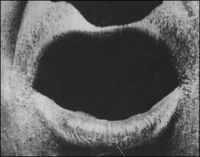Linguistics
From The Art and Popular Culture Encyclopedia
|
"[...] since Words are only Names for Things, it would be more convenient for all Men to carry about them, such Things as were necessary to express the particular Business they are to discourse on."--"A Scheme for abolishing all Words" (1726) by Jonathan Swift "Cratylus and Hermogenes illuminate the two positions [in the sound symbolism debate]. On the one hand the naturalists, i.e. believers in what is nowadays known as sound symbolism, on the other the conventionalists, the non-believers of said theory. The extreme of their arguments go something like this: if sound symbolism were true, if ‘the sound of a word affects its meaning, then you should be able to tell what a word means just by hearing it. There should be only one language.’ (Magnus, 2013). Because this is manifestly not the case, naturalists are believed to be wrong. The naturalists’ evidence has been scarcer and it has been the poets who have come to their aid making for convincing but always anecdotal evidence. As Anatoly Liberman (born 1937) notes: ‘Consider the English words “glow, gleam, glimmer, glare, glisten, glitter, glacier, and glide.” They suggest that in English the combination gl- conveys the idea of sheen and smoothness. Against this background, glory, glee and glib emanate brightness by their very form, glance and glimpse reinforce our conclusion (because eyesight is inseparable from light), and glib has no other choice than to denote specious luster, and, indeed, in the sixteenth century, when it became known in English, it meant “smooth and slippery.”’"--"Meaning, Sound and Vision" (2017) by J.-W. Geerinck |


Illustration: a close-up of a mouth in the film The Big Swallow (1901)
|
Related e |
|
Featured: |
Linguistics is the scientific study of language, and involves an analysis of language form, language meaning, and language in context. The earliest activities in the documentation and description of language have been attributed to the 4th century BCE Indian grammarian Pāṇini, who wrote a formal description of the Sanskrit language in his Aṣṭādhyāyī.
Linguists traditionally analyse human language by observing an interplay between sound and meaning. Phonetics is the study of speech and non-speech sounds, and delves into their acoustic and articulatory properties. The study of language meaning, on the other hand, deals with how languages encode relations between entities, properties, and other aspects of the world to convey, process, and assign meaning, as well as manage and resolve ambiguity. While the study of semantics typically concerns itself with truth conditions, pragmatics deals with how situational context influences the production of meaning.
Grammar is a system of rules which governs the production and use of utterances in a given language. These rules apply to sound as well as meaning, and include componential sub-sets of rules, such as those pertaining to phonology (the organisation of phonetic sound systems), morphology (the formation and composition of words), and syntax (the formation and composition of phrases and sentences). Modern theories that deal with the principles of grammar are largely based within Noam Chomsky's framework of generative linguistics.
Early grammarians
An early formal study of language was in India with Pāṇini, the 6th century BC grammarian who formulated 3,959 rules of Sanskrit morphology. Pāṇini's systematic classification of the sounds of Sanskrit into consonants and vowels, and word classes, such as nouns and verbs, was the first known instance of its kind. In the Middle East, Sibawayh, a Persian, made a detailed description of Arabic in AD 760 in his monumental work, Al-kitab fii an-naħw, The Book on Grammar), the first known author to distinguish between sounds and phonemes (sounds as units of a linguistic system). Western interest in the study of languages began somewhat later than in the East, but the grammarians of the classical languages did not use the same methods or reach the same conclusions as their contemporaries in the Indic world. Early interest in language in the West was a part of philosophy, not of grammatical description. The first insights into semantic theory were made by Plato in his Cratylus dialogue, where he argues that words denote concepts that are eternal and exist in the world of ideas. This work is the first to use the word etymology to describe the history of a word's meaning. Around 280 BC, one of Alexander the Great's successors founded a university (see Musaeum) in Alexandria, where a school of philologists studied the ancient texts in Greek, and taught Greek to speakers of other languages. While this school was the first to use the word "grammar" in its modern sense, Plato had used the word in its original meaning as "téchnē grammatikḗ", the "art of writing", which is also the title of one of the most important works of the Alexandrine school by Dionysius Thrax. Throughout the Middle Ages, the study of language was subsumed under the topic of philology, the study of ancient languages and texts, practised by such educators as Roger Ascham, Wolfgang Ratke, and John Amos Comenius.
See also
- Alfred Korzybski
- Sapir-Whorf
- Noam Chomsky
- George Lakoff
- Gregory Bateson
- Semantics
- History of linguistics
- Sound symbolism


